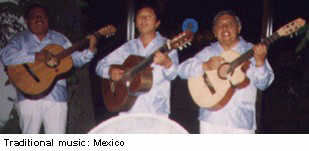Sections: Asian Culture | Hispanic Culture | Native American Culture | Shiite Muslim Culture| Russian Culture| Zambian Culture
Activities: Asian Case Study | Hispanic Case Study | Native American Case Study | Muslim, Russian & Zambian Case Study

Note: This section is abbreviated and does not provide comprehensive coverage of all Hispanic populations. This section generally concentrates on the Mexican-American population.
- Value Orientations (Seidel, Ball, Dains, & Benedict, 1996, p. 39):
- Time--Present oriented; lives by the day; relaxed sense of time.
- Activity--Expresses self spontaneously.
- Human Nature--Need to exhibit self-control to avoid evil orientation; little control over destiny.
- Relation--Group goals take precedence over individual goals.
- Health Beliefs

- Health is strongly related to religion. Illness is caused by an imbalance of caliente (hot) and frio (cold) and is seen as punishment from God (Seidel et al., pp. 48, 50).
- Good behavior is rewarded by good health (e.g., eating properly, engaging in work, practicing religion) (Seidel, et al., pp. 48, 50).
- Beliefs about illnesses affecting the gravid woman and infants include:
- empacho (blocked intestine)/improper or poorly cooked foods stick to the intestine causing blockage,
- susto (fright sickness)/real or imagined traumatic events cause illness,
- mal de ojo (evil eye)/illness affecting children caused by admiration of others,
- caida de mollera (fallen fontanel)/caused by improper handling of infant,
- antojos (cravings)/infants may have characteristics of certain foods if cravings not satisfied during pregnancy (e.g. strawberry birth mark),
- cuarentena (40 days)/dietary and activity restrictions are followed during the 40 days postpartum to promote bonding and prevent future illnesses (Burk, Wieser, & Keegan, 1995, p. 44)
- Other beliefs related to health care include:
- mal de aire (bad/cold air)/causes imbalance leading to premature labor, cramps, and some
neurological symptoms; in infants, this
 may cause respiratory difficulties,
may cause respiratory difficulties, - encono (festering wounds)/wounds and scars may become infected by exposure to certain individuals (DePacheco & Hutti, 1998, pp. 16).
- mal de aire (bad/cold air)/causes imbalance leading to premature labor, cramps, and some
neurological symptoms; in infants, this
- Health Practices (Seidel et al., pp. 48-50)
- Treats illness through promises with God and prayers.
- Seek help from others such as folk healers (curandero/curandera) rather than Western medicine. Utilizes herbal medicine and rituals in treatment.
- Modesty may serve as a barrier to medical care.
- The National Alliance for Hispanic
Health web site
 provides facts about breast cancer in Hispanic women. It speaks to the delay between
abnormal mammograms and follow-up as well as the standard of practice for treatment.
provides facts about breast cancer in Hispanic women. It speaks to the delay between
abnormal mammograms and follow-up as well as the standard of practice for treatment.
- Dietary Considerations
- Prevention and treatment of illness may include dietary considerations for "hot" and "cold" foods. Cool foods are medications are not consumed during the postpartum period. This promotes the emptying of the uterus which is considered to be "warm". The diet may also include clear soups, chicken, and herbal teas (DePacheco et al., p. 20).
- Folk remedies may have "negative" consequences. For example baking soda may be prescribed to avoid heartburn. Mannitol tea may be used but can act as a diuretic leading to dehydration (DePacheco et al., p. 18).
- During the menstrual period and during the postpartum period women avoid spicy and acidic foods believing this will cause increased flow or cramps (DePacheco et al., p. 19).
- May suffer from lactose intolerance.
- Family Aspects
- Extended families are important (Seidel et al., p. 49).
- Females are subordinate to males who financially support the family (Seidel at al., p. 49).
- Deference to the elderly, especially elderly males, is important. Nurses should seek permission from the head of the family for treatment of individual members (Zoucha & Zamarripa, 1997, p. 272).
- Communication Practices

- May prefer to Spanish especially when under stress. (Seidel et al., p. 49)
- Care is seen as time and attention therefore nursing care should not be rushed and conversation is important (Zoucha et al., p.272).
- Physical Assessment (Jarvis, 1996, pp. 217, 356) (Note: The following characteristics
may be found more frequently in individuals of this minority group.)
- Skin/Hair: Melanin causes darker skin tones especially noticeable in the perineal area and nipples.
- Common Health Conditions
- High incidence of hypertension (and smoking) (Jarvis, p. 527). Heart disease and strokes are numerous (Burk et al, p. 44).
- Relatively high cholesterol levels (Jarvis, p. 527).
- Obesity among women (Jarvis, p. 527). Obese women are more likely to develop gallstones (Burk et al., pp. 44).
- High risk of developing diabetes (Jarvis, p. 527). Type II non-insulin dependent diabetes is two or three times more prevalent with progression to retinopathy and renal disease (Burk et al., p. 44).
- Latinos comprise 12% of the U.S. population and 18% of those with AIDS. Tuberculosis, as a consequence of AIDS, is four times greater than non-Hispanics (Burk et al., p. 44).
- Rice University offers information
about common diseases
 affecting Hispanic individuals. Heart disease is prevalent. Cancer is the second leading
cause of death. Diabetes is also frequently seen.
affecting Hispanic individuals. Heart disease is prevalent. Cancer is the second leading
cause of death. Diabetes is also frequently seen. - Embarrassment, use of cold speculums believed to be unclean, and discomfort were beliefs influencing Latino women in obtaining Pap smears (Jennings, 1997, p. 827).
- "Culture Bound Syndromes" (Jarvis, p. 55)
- "Empacho"--food forms balls in the intestinal track leading to cramps.
- "Fatique"--symptoms mimicking asthma.
- " Mal ojo" ("Evil eye")--sleep disorder, crying, diarrhea.
- Genetic Disorders

- None noted.
- Pharmacological Considerations
- May require lower doses of antidepressants such as imipramine, desipramine, amitriptyline, and clomipramine. Side effects are greater than for Caucasians (Levy, 1993, p. 26).
- "Hot" medications are avoided during pregnancy. These include, among others, aspirin, iron, penicillin, and prenatal vitamins. Prenatal vitamins may be balanced by taking them with a "cool" liquid such as fruit juice, with the exception of orange juice (DePacheco et al., p. 19).
References:
- Burk, M. E., Wieser, P. C., & Keegan, L. (1995). Cultural beliefs and health behaviors of pregnant Mexican-American women: Implications for primary care. Advances in Nursing Science, 17, 37-52.
- DePacheco, M. R., & Hutti, M. H. (1998). Cultural beliefs and health care practices of childbearing Puerto Rican American women and Mexican American women: A review of the literature. Mother Baby Journal, 3 (1), 14-25.
- Jarvis, C. (1996). Physical examination and health assessment (2nd ed.). Philadelphia, PA: W. B. Saunders.
- Jennings, K. M. (1997). Getting a Pap smear: Focus group responses of African American and Latina women. Oncology Nursing Forum, 24, 827-835.
- Levy, R. (1993). Ethnic & racial differences in response to medicines. Reston, VA: National Pharmaceutical Council.
- Seidel, H. M, Ball, J. W., Dains, J. E., & Benedict, G. W. (1995). Mosbys guide to physical examination (3rd ed.). St. Louis, MO: Mosby.
- Zoucha, R., & Zamarripa, C. (1997). The significance of culture in the care of the client with an ostomy. Journal of Wound, Ostomy, and Continence Nursing, 24, 270-276.
Photo Credits:
- Photographs courtesy of A. Gray and C. Todero, College of Nursing, UNMC.
Additional Photographs
Click on an image to view it. For a description of the image position the mouse pointer over the picture for a few seconds.
Bibliography:
- Campbell, J. C., & Campbell, D. W. (1996). Cultural competence in the care of abused
women. Journal of Nurse-Midwifery, 41, 457-462.
Issues related to the assessment and care of abused women of various cultures are reviewed. A large number of Spanish speaking individuals live in the United States. When these individuals seek health care, and abuse/violence is suspected, the clinician should not rely on a family member to act as an interpreter.
- Jimenez, S. L. M. (1995). The Hispanic culture, folklore, and perinatal health. The
Journal of Perinatal Education, 4 (1), 9-16.
Diabetes is frequently found in the Hispanic population so pregnant women with diabetes must be addressed. Health care may be difficult to access because of economics, lack of transportation/child care/release time from work, and language barriers. Pregnant women believe that health and illness are controlled by God. Mexican women call this fatalismo or destino. Nothing can be done to intervene. Women also hold dependent relationships and may view health care personnel as a parent-like figure. Families are important support systems as well; families play an important role in decision making about health care. Health beliefs and folk healing are briefly discussed. During childbirth touch is appropriate. Some women also accept massage, acupressure, and therapeutic touch. Herbal teas are frequently used for the discomforts of pregnancy. During labor, the Mexican woman may express her discomfort vocally. Heat and cold are concerns, with neonates and postpartum women being susceptible to "cold". If the feet are wet then the head must be wet or "cold"enters the body. This has implications for bathing. During the postpartum period women are seen as vulnerable and bed rest is often practiced. Infants often have abdominal binders in place, sometimes holding a coin over the navel, to prevent hernias.
- Miller, M. A. (1995). Culture, spirituality, and womens health. JOGNN, 24,
257-263.
Relationships between culture, religious beliefs, and women's health are explored. A variety of cultures and beliefs are reviewed. Hispanic individuals cope with illness through their belief about God's will. Motherhood is important within this culture. These beliefs have implications for health promotion and teaching about contraception.
- Rajaram, S., & Rashidi, A. (1999). Cultural issues & breast cancer
screening. Olson Center for Women's Health, 4(4), 1,3.
Latinos, African Americans, and Native Americans have a higher incidence of breast cancer than Caucasians and are less likely to use mammograms. This is, in part, related to cultural beliefs. Latinos may believe that "bad behavior" causes breast cancer and that compression of the breast and the use of radiation may cause cancer. Modesty is also a factor for Latinos and Asians. Some Latinos also believe that only husbands/lovers should touch breasts. African Americans may believe that the mental stress of a breast cancer diagnosis is worse than the disease itself. In the Navajo culture discussion of cancer conflicts with health maintainence through positve "ritual" language.
- Sheridan-Leos, N. (1995). Women's health Loteria: A new cervical cancer education tool for Hispanic females. Oncology Nursing Forum, 22, 697-701. A tool, modeled after a popular Hispanic card game is described. The tool is used to teach women about cervical health.
- Villarruel, A., & Leininger, M. (1995). Culture care of Mexican Americans. In M.
Leininger, Transcultural Nursing Concepts, Theories, Research & Practice (pp.
365-382). New York, NY: McGraw-Hill.
Detailed facts about the Mexican-American culture are provided including the historical aspects. Beliefs about folk medicine such as the oneness of body and mind are addressed. Religious and supernatural aspects are important in this culture as well as communication between the natural and supernatural worlds. Patients are viewed as victims and healers are used. Nursing interactions should include the participation of other family members in the care plan, support of cultural beliefs, emphasis upon the present rather than future, the use of touch, the protection of modesty, and facilitation of communication.
Web Addresses:
Hispanic individuals will represent the largest minority group in the United
States by the year 2000. The National Hispanic Health Symposium was convened to
review the needs of the Hispanic community for health and human services. Regional
plans were developed. Recommendations
![]() are shared in this web
site.
are shared in this web
site.
Recommendations from the National
Hispanic Health Symposium ![]() for Iowa, Kansas, Missouri, Nebraska,
Colorado, Montana, North Dakota, South Dakota, Utah, and Wyoming.
for Iowa, Kansas, Missouri, Nebraska,
Colorado, Montana, North Dakota, South Dakota, Utah, and Wyoming.
Next Section - Native American




